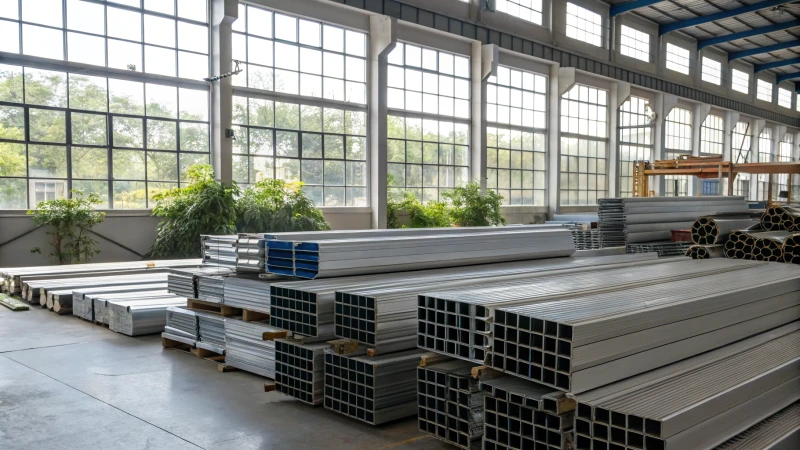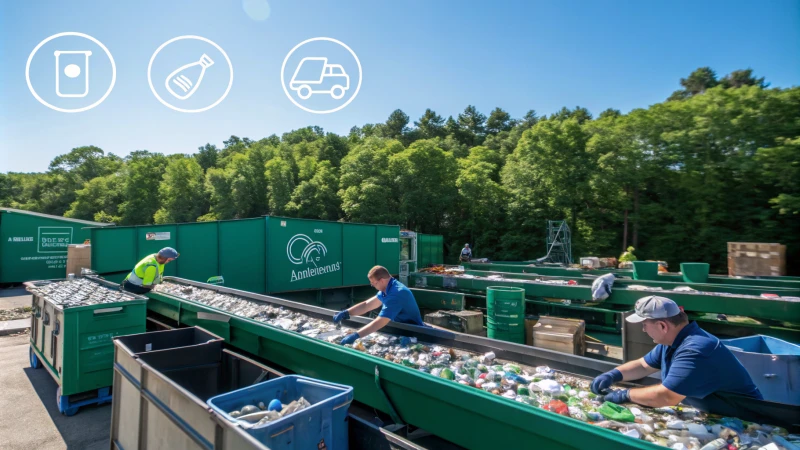The Rise of Sustainable Building Materials: The Role of Aluminum Profiles

Sustainability in construction is more crucial than ever, and aluminum profiles are leading the charge toward eco-friendly building practices.
Aluminum profiles revolutionize sustainable building by being highly recyclable, reducing energy consumption by up to 95% compared to new extraction. They meet stringent green building standards and boast a low-carbon production process, making them ideal for environmentally conscious construction projects.
While this provides a brief overview, the depth of aluminum’s impact on sustainable building extends beyond its recyclability. Dive deeper to explore how aluminum’s attributes and production advancements contribute to a greener future in construction.
Aluminum profiles reduce energy consumption by 95%.True
Recycling aluminum uses 95% less energy than producing new aluminum.
Aluminum profiles are not recyclable.False
Aluminum is highly recyclable, making it eco-friendly for construction.
What Makes Aluminum Profiles a ‘Green Strategic Metal’?
Aluminum profiles are hailed as ‘green strategic metals’ due to their exceptional recyclability and energy-efficient production. This makes them a top choice for eco-conscious industries.
Aluminum profiles are considered ‘green strategic metals’ because they can be recycled with up to 95% energy savings, significantly reducing greenhouse gas emissions and supporting sustainable development.

The Recyclability of Aluminum
Aluminum’s high recyclability stems from its ability to retain properties after recycling. The process consumes less energy than extracting from ore. This lowers environmental impact1 and conserves resources.
| Feature | Benefits |
|---|---|
| High Recyclability | Saves energy, reduces emissions |
| Durability | Long lifespan, less waste |
Meeting Green Building Standards
Aluminum profiles comply with stringent green building standards. Low VOCs in adhesives reduce indoor pollution. Their strength supports high-performance design, minimizing maintenance and resource consumption2.
Innovations in Production
Modern production methods control the carbon footprint. Advanced technologies in the electrolytic process increase efficiency and decrease emissions, aligning with low-carbon economy goals.
- Dry Purification: Treats exhaust gases, reducing pollution.
- Efficient Cells: Enhance energy use, decrease emissions.
Government Support for Eco-Friendly Materials
Global policies promote eco-materials through incentives, encouraging sustainable technologies. This fosters a favorable environment for the aluminum profile industry, aiding businesses to invest in green innovations3.
Aluminum retains properties after recycling.True
Aluminum can be recycled without losing its inherent properties.
Aluminum profiles emit high VOCs indoors.False
Aluminum profiles use low VOC adhesives, reducing indoor pollution.
How Do Aluminum Profiles Meet Green Building Standards?
Aluminum profiles are at the forefront of sustainable construction materials, meeting green building standards through recyclability, low-carbon production, and durability. Discover how these versatile components contribute to eco-friendly architecture.
Aluminum profiles meet green building standards by offering high recyclability, energy-efficient production, and compliance with low-VOC regulations. Their durability and government policy support further enhance their eco-friendly credentials.

The Recyclability Factor
Aluminum is renowned for its recyclability, with a recycling process that uses only 5% of the energy needed to produce new aluminum. This remarkable energy efficiency4 makes it a top choice for sustainable construction.
| Feature | Benefit |
|---|---|
| Recyclability | Saves energy and reduces waste |
| Durability | Prolongs lifecycle of buildings |
Compliance with Green Building Standards
Aluminum profiles comply with various green building standards by utilizing low-VOC adhesives and coatings. These materials help reduce indoor air pollution, improving occupant health and comfort. Additionally, their strength supports high-performance building designs5.
Reducing Carbon Footprint in Production
Innovations in aluminum production, like dry purification technologies, help reduce carbon emissions. The use of modern electrolytic cells further enhances energy efficiency, aligning with the goals of a low-carbon economy. This technological advancement6 underscores aluminum’s role in sustainable development.
Government Support for Eco-Friendly Materials
Governments worldwide incentivize the use of eco-friendly materials through supportive policies. These policies encourage companies to adopt sustainable practices, fostering growth in the aluminum profile industry. Businesses benefit from these incentives, which promote investment in green technologies and innovations7.
Aluminum recycling uses 5% of the energy for new production.True
Recycling aluminum requires only 5% of the energy compared to producing new aluminum.
Aluminum profiles do not comply with green building standards.False
Aluminum profiles comply with standards by using low-VOC materials and efficient production.
What Are the Environmental Benefits of Recycling Aluminum?
Recycling aluminum is a powerful tool in the fight against environmental degradation. Not only does it conserve natural resources, but it also significantly reduces energy consumption and greenhouse gas emissions.
Recycling aluminum saves up to 95% of the energy required to produce new aluminum from raw ore. This process drastically cuts greenhouse gas emissions, conserves natural resources, and reduces landfill waste.

Energy Efficiency and Emission Reduction
The energy savings from recycling aluminum are monumental. Producing new aluminum from bauxite ore requires intense energy, primarily due to the electrolysis8 process. Recycling, however, skips this step entirely, utilizing only a fraction of the energy. This efficiency translates to a reduction in emissions. For every ton of recycled aluminum, approximately 10 tons of CO2 emissions are avoided.
Conservation of Natural Resources
Aluminum is derived from bauxite ore, a finite resource. By recycling, we conserve these natural reserves. The mining process itself is environmentally disruptive, causing deforestation and habitat destruction. Recycling mitigates these effects by reducing the demand for new mining projects.
Reducing Landfill Waste
Aluminum’s recyclability contributes significantly to reducing landfill waste. Unlike many materials, aluminum can be recycled indefinitely without losing quality. This attribute ensures that used aluminum products are continually reprocessed into new products, keeping them out of landfills.
Economic and Environmental Synergies
Recycling aluminum not only benefits the environment but also fosters economic growth. The recycling industry creates jobs and stimulates innovation in green technologies9. Furthermore, it supports a circular economy where resources are reused rather than discarded.
Here’s a brief table illustrating the benefits:
| Benefit | Impact |
|---|---|
| Energy Savings | Up to 95% less energy used |
| Emission Reduction | 10 tons of CO2 saved per ton |
| Resource Conservation | Reduces need for new bauxite |
| Waste Reduction | Keeps aluminum out of landfills |
| Economic Growth | Boosts jobs in recycling sector |
By understanding these benefits, we can appreciate why aluminum recycling is integral to achieving sustainability goals.
Recycling aluminum saves 95% of the energy used in new production.True
Recycling skips the energy-intensive electrolysis process, saving 95% energy.
Aluminum recycling requires more energy than producing new aluminum.False
Recycling uses a fraction of the energy compared to new production from bauxite.
How Are Government Policies Supporting the Use of Eco-Friendly Materials?
Governments worldwide are pivotal in promoting eco-friendly materials, driving innovation and sustainability in various industries. Their policies incentivize sustainable practices, reducing environmental impact and boosting green technology.
Governments support eco-friendly materials through financial incentives, regulatory standards, and research funding. These measures encourage businesses to adopt sustainable practices and innovate in green technologies, fostering a more sustainable economy.

Financial Incentives and Subsidies
Many governments offer financial incentives such as tax credits and subsidies to companies using eco-friendly materials10. These incentives lower operational costs, making it economically viable for businesses to switch to sustainable materials. For instance, grants may be offered to industries investing in recycling technologies.
| Country | Incentive Type | Description |
|---|---|---|
| USA | Tax Credit | Credits for using renewable energy resources |
| Germany | Subsidy | Subsidies for implementing green building solutions |
| Japan | Low-interest loans | Loans for eco-friendly technology investments |
Regulatory Standards and Compliance
Governments establish strict standards and compliance measures to ensure the use of eco-friendly materials. Regulations often require companies to meet green building standards11 or use materials with minimal environmental impact. Compliance not only benefits the environment but also enhances brand reputation.
- Example: The European Union’s REACH regulation restricts hazardous substances, promoting safer alternatives.
Research Funding and Innovation Support
Research funding from governmental bodies propels innovation in sustainable materials. By financing university and private sector research, governments foster the development of new materials and technologies. This approach leads to breakthroughs that make eco-friendly alternatives12 more accessible and cost-effective.
Key Research Initiatives
-
Program: Horizon Europe
- Focus: Supports R&D projects for sustainable materials.
-
Initiative: Green Chemistry
- Objective: Develops new biodegradable materials.
Global Collaboration and Policy Frameworks
International agreements and collaborations play a crucial role. By participating in global initiatives like the Paris Agreement, countries commit to reducing carbon emissions through sustainable practices. These frameworks provide a platform for sharing best practices13 and innovations across borders, enhancing the global transition to eco-friendly materials.
Governments’ supportive policies are instrumental in encouraging the use of eco-friendly materials, promoting a sustainable future through incentives, regulations, research funding, and international cooperation.
Governments offer tax credits for eco-friendly materials.True
Many governments provide tax credits to incentivize the use of sustainable materials.
Global agreements hinder the use of eco-friendly materials.False
International frameworks like the Paris Agreement promote sustainable practices globally.
Conclusion
Aluminum profiles are pivotal in sustainable construction, offering high recyclability, low energy consumption, and compliance with green building standards, supported by government incentives for eco-friendly materials.
-
Explore how aluminum recycling conserves energy and resources, contributing to environmental protection. ↩
-
Learn how low VOC materials improve indoor air quality and promote health. ↩
-
Understand how government incentives drive sustainable material adoption and innovation. ↩
-
This link elaborates on the energy savings achieved through aluminum recycling, enhancing your understanding of its eco-friendly benefits. ↩
-
Explore how low-VOC materials contribute to healthier indoor environments, an essential aspect of green building standards. ↩
-
Discover the latest innovations in aluminum production that reduce carbon emissions, supporting sustainable construction goals. ↩
-
Learn about government policies that promote the use of sustainable materials in construction, aiding in eco-friendly innovation. ↩
-
Understanding electrolysis helps grasp why recycling aluminum is more energy-efficient than producing it from raw ore. ↩
-
Exploring green technologies reveals innovations that enhance the sustainability of aluminum recycling processes. ↩
-
Discover specific financial benefits businesses can receive when they use eco-friendly materials. ↩
-
Learn how compliance with green building standards can improve sustainability and reputation. ↩
-
Explore the latest innovations making eco-friendly alternatives more viable. ↩
-
Understand how international collaborations drive the use of sustainable materials. ↩



